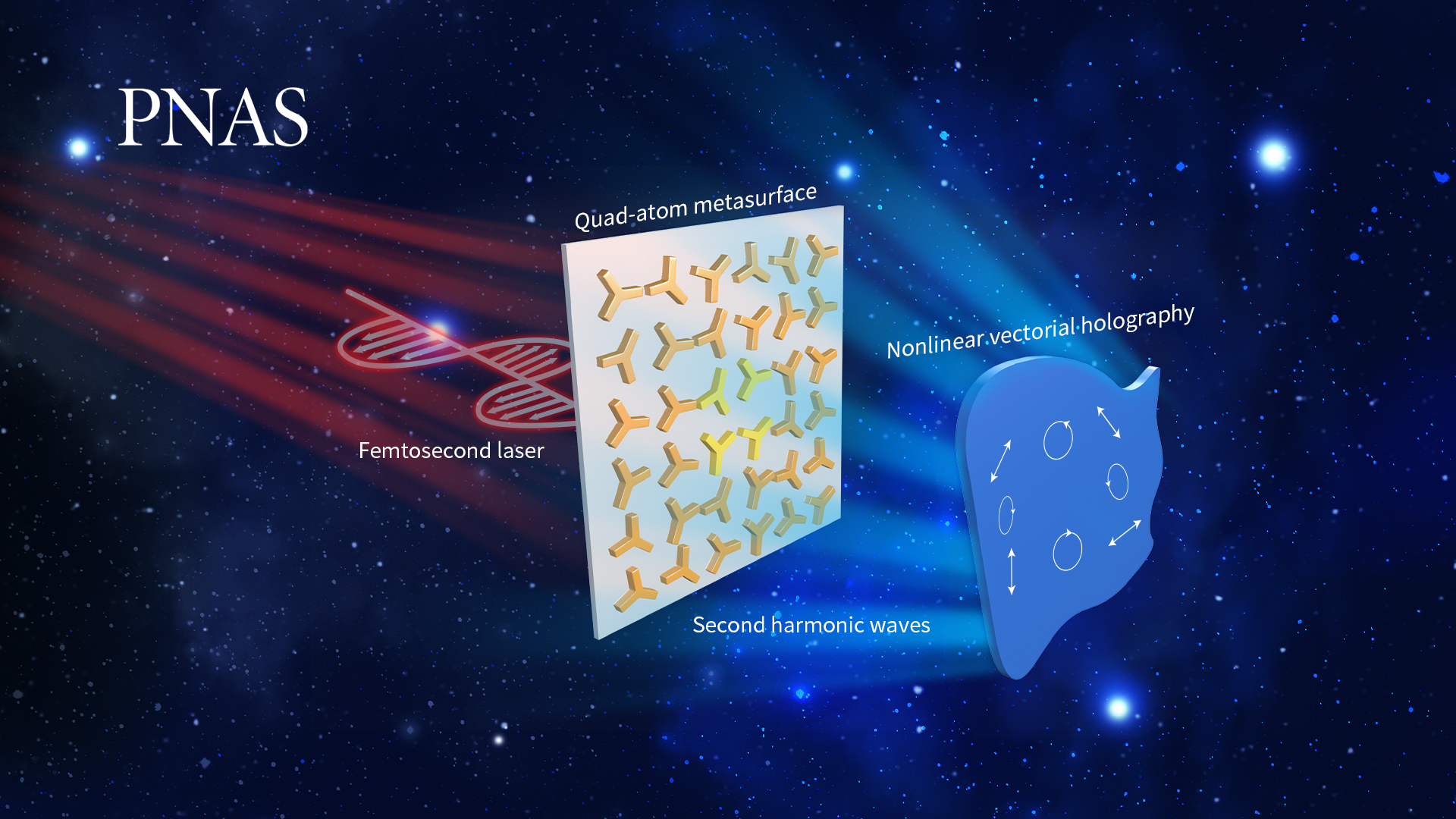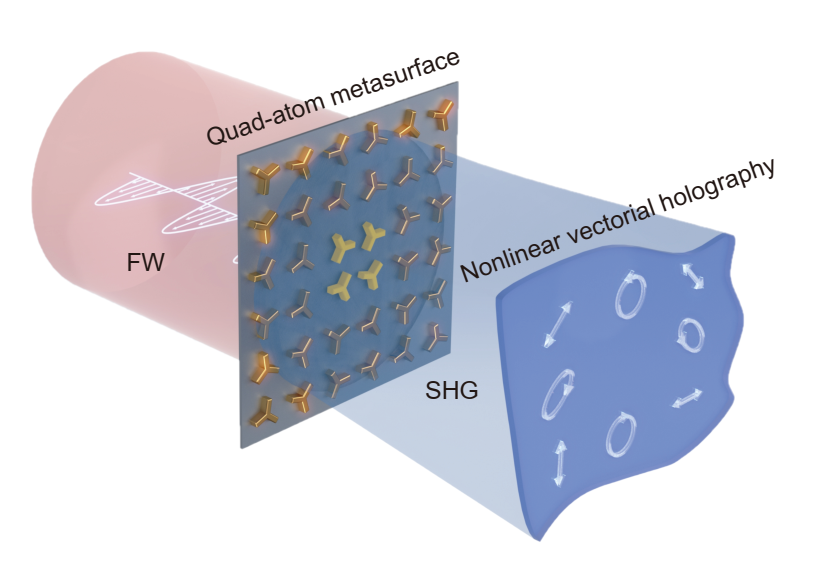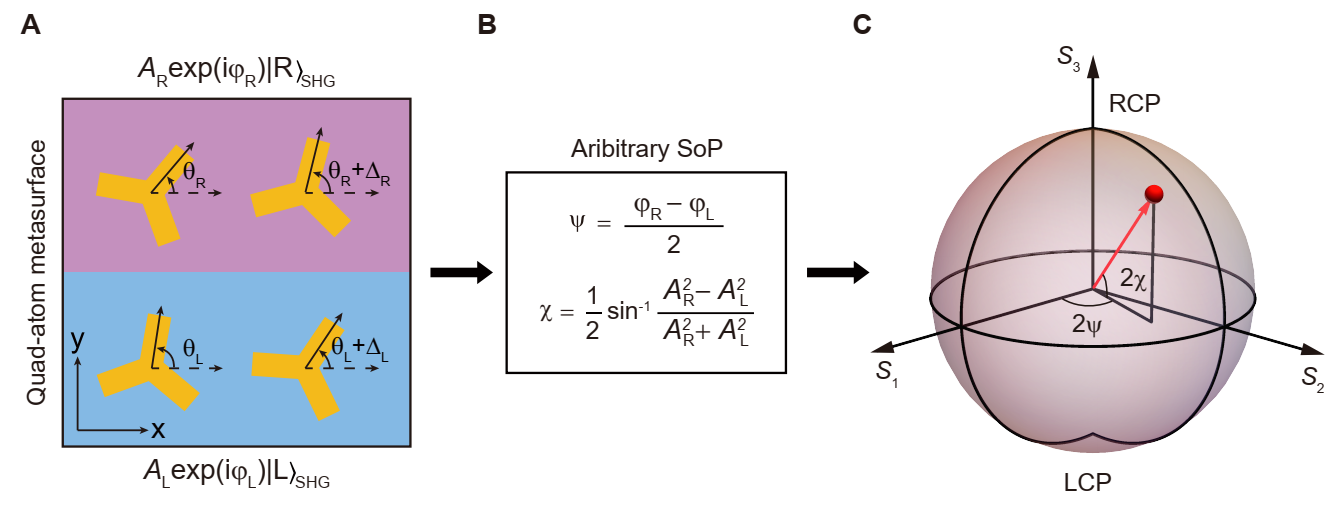Since proposed by Dennis Gabor, the Nobel Prize laureate in physics, Optical holography, which can be used to reconstruct the wavefront of light, has been successfully applied in many areas, such as advanced microscopy, data storage, display, optical tweezer, optical communications, and quantum science.
Having attracted numerous attention in the past decades, vectorial polarization holography was developed by using photoanisotropic materials, such as Azobenzene, silver-halide materials, liquid crystal polymers, and so on. Many polarization-sensitive optical holographic devices have been produced. However, this kind of polarization holography is usually limited by the working wavelength of light and is only able to reconstruct two wavefronts with orthogonal polarizations. The advent of optical metasurfaces brings new opportunities for the development of vectorial polarization holography.

Professor Guixin Li’s research team at the Southern University of Science and Technology (SUSTech) has recently made advances in nonlinear optical vectorial holography. In this study, the metasurface consists of gold meta-atoms with threefold rotational symmetry and exhibits a plasmonic resonance effect in the near-infrared (NIR) spectral region. Based on the concept of nonlinear geometric phase, we can simultaneously manipulate both the phase and amplitude of the left and right circularly polarized second harmonic (SH) waves generated from the quad-atom metasurface. By combining the methods of computer-generated hologram and reverse design, the metasurface can produce nonlinear holographic images with arbitrary polarization distributions.
Their paper, entitled “Nonlinear vectorial holography with quad-atom metasurfaces,” was published in the Proceedings of the National Academy of Sciences of the United States of America (PNAS).
The optical metasurfaces, which consist of spatially variant plasmonic or dielectric meta-atoms, have been extensively used to manipulate the phase, polarization, and amplitude of light. Compared with the photoanisotropic materials, which are sensitive to a specific wavelength range of light, the metasurface as an artificial structure can be easily designed at ultraviolet to infrared, terahertz, and even longer wavelengths. All these properties make optical metasurface more practical for vectorial holography applications.
By combining the geometric phase and resonant phase or topological phase, the multiplexed holography with orthogonal circular polarization states can be achieved. Later, the multiple-polarization input and multiple-polarization output were also utilized to design the metasurface vectorial holograms. In recent times, the vectorial holography based on one polarization input was also demonstrated by engineering the meta-molecules of the metasurface or by using the protocol of Jones matrix holography.
In the nonlinear optical regime, based on the concept of nonlinear geometric phase, the researchers can continuously manipulate the phase of the SH waves from meta-atoms with threefold rotational symmetry. In their previous work, they proposed to simultaneously manipulate the wavefront of the generated SH waves in the real and Fourier spaces, and achieved image storage and holographic imaging functions based on the nonlinear optical metasurfaces. The main mechanisms are that they designed a diatomic meta-molecule consisting of two meta-atoms with threefold rotational symmetry, which enables the simultaneous control of the phase, polarization, and amplitude of the SH waves. In the regime of nonlinear optical holography, it is still challenging to control the light intensity and polarization with arbitrary spatial distributions.
In this work, the nonlinear optical vectorial holography based on geometric phase-controlled metasurfaces was reported. Under the pumping of a linearly polarized NIR fundamental wave, the SH waves carrying geometric phases are radiated from the gold meta-atoms with a plasmonic resonance effect (Fig. 1). By controlling the orientation angles of the four meta-atoms in a meta-molecule, the phase and amplitude of both left and right circularly polarized SH waves can be manipulated independently. By further combining CGH and reverse design method, the metasurface can produce SH holographic images with arbitrary polarization distributions.

Figure 1. Nonlinear vectorial optical holography based on geometric phase metasurfaces. Under the pumping of a linearly polarized femtosecond laser, the quad-atom metasurface consists of gold meta-atoms with threefold rotational symmetry that generates SH signals, which contain an SH vectorial holographic image with arbitrary polarization distributions.
By designing the quad-atom meta-molecule, which consists of four meta-atoms, Prof. Li’s team could independently manipulate the phase and amplitude of both left and right circularly polarized SH waves (Fig. 2). Based on such a design concept for metasurfaces, they achieved the arbitrary manipulation of the polarization parameters of SH waves (the main axis angle ψ and the ellipticity angle χ).

Figure 2. Design principle of the nonlinear quad-atom metasurface. (A) The schematic illustration of a unit cell of the quad-atom metasurface. The top and bottom groups (upper and lower, respectively), which consist of two C3 meta-atoms, are used to independently control the amplitude and phase of the SH waves with RCP and LCP states. (B) The main axis angle ψ and the ellipticity angle χ can be represented by the phase and amplitude of the left and right circularly polarized SH waves. (C) ψ and χ can be used to represent any point on the surface of the Poincaré sphere.
For the holographic image with spatially variant polarization states, the researchers combined the Gerchberg-Saxton (GS) algorithm and the method of reverse design to calculate the corresponding phase distribution of the SH waves (Fig. 3). The holographic image of a “flag” contains two circular polarization states and two elliptical polarization states. Theoretically, they could generate an SH holographic image with an arbitrary distribution of the polarization states by using this method. Afterward, by using the electron beam lithography and electron beam evaporation deposition, the gold metasurface was fabricated on the ITO-coated glass substrate. According to the calculated and measured polarization parameters, it confirmed that the nonlinear optical vectorial holography based on quad-atom metasurfaces was successfully realized.

Figure 3. The nonlinear optical vectorial holographic images. (A) The target image “flag” and the distribution of the designed polarization states. (B and C) The calculated phase distributions experienced by the SH waves with RCP and LCP states. (D) The scanning electron microscope image of the gold metasurface. (Inset) The dashed box indicates a unit cell of the metasurface. (Scale bar, 500 nm.) (E-H) The calculated and measured main axis angle ψ and ellipticity angle χ.
Prof. Li’s team proposed a quad-atom nonlinear optical metasurface based on a nonlinear geometric phase and achieved nonlinear optical vectorial holography. By controlling the orientation directions of the gold meta-atoms, they could manipulate multiple degrees of freedom of the SH waves, including polarization, phase, amplitude, and so on. By combining the GS algorithm and the method of reverse design, they verified the ability to realize the nonlinear optical vectorial holography with multiple polarization states. The proposed metasurface platform may have important applications in nonlinear optical sources, high-capacity optical information storage, and optical encryption.
Ningbin Mao and Guanqing Zhang, Ph.D. students of Prof. Guixin Li’s research group at SUSTech, and Dr. Yutao Tang, a postdoctoral research fellow at SUSTech, are the co-first authors of this paper. Prof. Guixin Li is the corresponding author. Ph.D. students Yang Li, Zixian Hu, Xuecai Zhang, and senior research scientist Dr. Kingfai Li at SUSTech, as well as Prof. Kok Wai Cheah from the Hong Kong Baptist University (HKBU) also participated in this research.
This work was supported by the National Natural Science Foundation of China (NSFC), Zhangjiang Laboratory, Guangdong Provincial Innovation and Entrepreneurship Project, and the Shenzhen Science and Technology Innovation Commission.
Paper link: https://www.pnas.org/doi/full/10.1073/pnas.2204418119
To read all stories about SUSTech science, subscribe to the monthly SUSTech Newsletter.
Proofread ByAdrian Cremin, Yingying XIA
Photo By